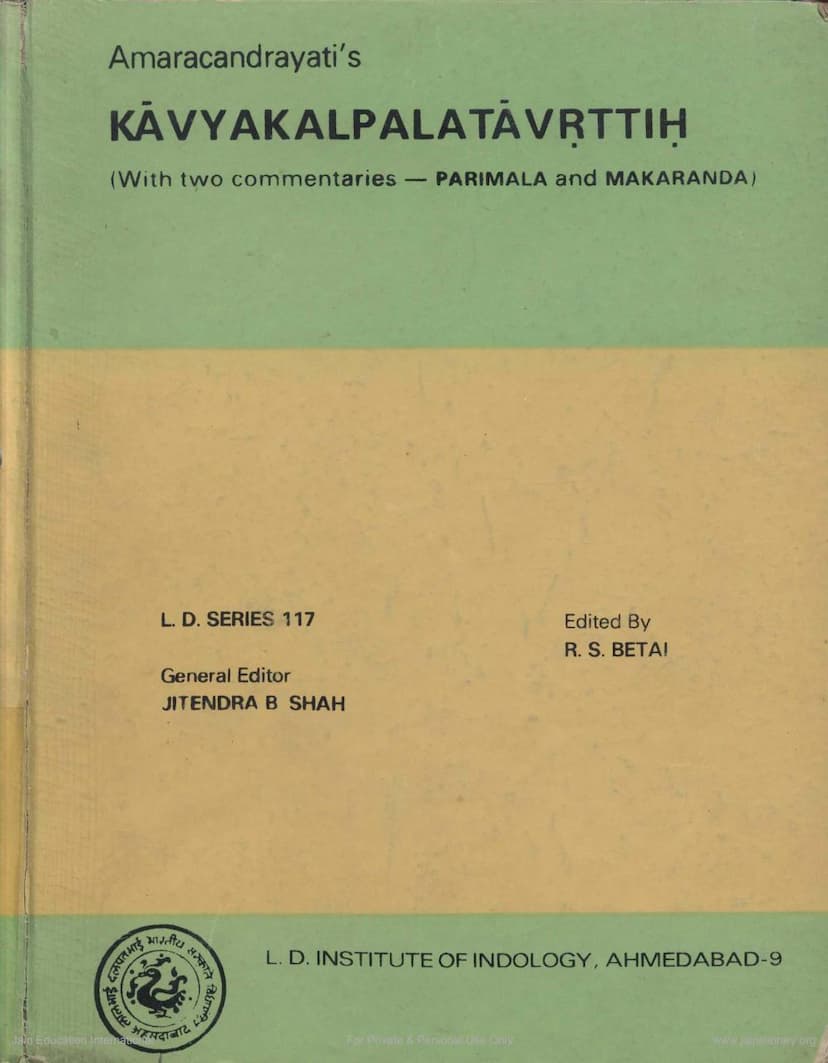Kavyakalpalatavrutti
Added to library: September 2, 2025

Summary
Here's a comprehensive summary of the Jain text, "Kavyakalpalatavrutti," based on the provided pages:
Title: Kavyakalpalatavrutti (with two commentaries - Parimala and Makaranda) Author: Amarchand Maharaj Editors/Compilers: R. S. Betai (Editor), Jitendra B. Shah (General Editor) Publisher: L. D.1ndology, Ahmedabad Series: L.D. Series 117 Publication Date: First Edition: July 1997
Overall Subject Matter:
This volume presents a critical edition of Amarchand Yati's Kavyakalpalata, a significant work on poetics (kavya). The book is notable for including two previously unpublished commentaries:
- Parimala: An autocommentary by Amarchand Yati himself, dating from the 13th century.
- Makaranda: A commentary by Shubhavijayagani, from the 17th century.
The Kavyakalpalata and its commentaries focus on the training and equipment of a poet, delving into crucial aspects of kavya such as meter (chandas), word (shabda), meaning (artha), and literary embellishments (alankaras), particularly shlesh (pun). The work is considered a positive addition to the field of Indian poetics for its detailed analysis of these topics, offering a systematic approach to poetic perfection.
Key Aspects of the Work and its Context:
-
The Original Work (Kavyakalpalata):
- Composed by Arisimha (12th century V.S.) as a sutra work, with Amarchand Yati claiming authorship of some of the sutras as well.
- Amarchand Yati later expanded and elaborated on his own work by composing the Vritti and the Parimala commentary.
- The work is divided into four main sections called Pratānas, further subdivided into Stabakas. The titles of these sections and stabakas indicate a focus on:
- Meter (Chanda-siddhi-pratana)
- Words (Shabda-siddhi-pratana)
- Meaning and Puns (Artha-siddhi-pratana)
- Figures of Speech (Alankara)
- It notably diverges from traditional poetics by not extensively discussing rasa (aesthetic sentiment) or dhvani (suggestion), instead focusing on the practical "devices of the craft" for poets.
-
Amarchand Yati's Scholarship:
- Belonged to the Svetambara sect and was a pupil of Jinadattasuri.
- A prominent Jain scholar with works attributed to him on various subjects.
- His scholarship is characterized by a thorough grasp of Indian culture, traditions, and various shastras (religious and philosophical texts), including Hindu and Buddhist works.
- He possessed a high standard of poetic taste, considering Kālidāsa and others as ideals.
- His expression is clear, smooth, and masterful, demonstrating a unique expertise in lexicography, wordplay, and shlesh.
- He approached his subject matter dispassionately, as a scholar.
- His continuous analysis of topics indicates a belief in the perpetual refinement of knowledge.
-
The Commentaries:
- Vritti: Amarchand Yati's own commentary on the Kavyakalpalata. It provides explanations and analysis of the sutras, citing rules of grammar, meter, and offering illustrations. However, it is noted as being incomplete, with comments only on a portion of the work.
- Parimala: Amarchand Yati's auto-commentary, considered more elaborate and detailed than the Vritti. It aims to fulfill needs identified during the writing of the Vritti, such as explaining previously uninterpreted sutras, further analyzing matter, and incorporating new points. It also serves to showcase his extensive knowledge across various shastras. It is unfortunately available only up to a part of the seventh Stabaka.
- Makaranda: Shubhavijayagani's commentary, which humbly claims to supplement Parimala. It adds valuable points and elaborations not found even in the Parimala. Shubhavijayagani shows great regard for Parimala, referring to it extensively and refraining from repeating points already covered. He expects poets to be well-versed in 18 shastras (adding four to Amarchand's implied 14).
-
Value and Significance:
- The work fills a gap in Sanskrit poetics by focusing on Kavi-shiksha (poet's training) with remarkable detail and comprehensiveness.
- It guides poets not only in aspiring to become poets but also those seeking higher levels of literary perfection.
- It provides insights into Amarchand Yati's systematic and evolving thought process on poetic training.
- The inclusion of the Parimala and Makaranda commentaries provides a fuller picture of Amarchand Yati's lifetime work and contributes significantly to the understanding of Kavi-shiksha.
- The publication is seen as a fitting tribute to Amarchand Yati's scholarship.
-
Comparison with Other Works:
- The introduction compares Kavyakalpalata with Vinayachandra Suri's Kavikalpalata, noting that while the purpose is similar (poetic training), Amarchand's work is wider in scope, more detailed, analytical, and exhaustive, particularly in its lists of words and treatment of shabda-shakti (word powers).
- It also briefly compares the work with the anonymous Kalpalata-viveka, highlighting the traditional content of the latter compared to the more specific focus on poet's training in Amarchand's work.
- A brief mention of Devesvara's Kavi Kalpalata is made, indicating that it closely follows Arisimha and Amarchand, borrowing extensively from their text.
Content Highlights:
- Extensive Lists of Words: The commentaries, especially Parimala and Makaranda, feature extensive lists of words classified by their properties, origins (like those derived from grammatical rules, taddhita, kr̥t), and meanings, often with etymological explanations.
- Detailed Analysis of Figures of Speech: The Alankara-bhyasa section discusses various figures of speech, providing examples and explanations.
- Categorization of Verbs and Actions: The work details various actions and their grammatical nuances, including those related to different stages of life, emotions, and natural phenomena.
- Poetic Devices: Amarchand Yati's focus is on the practical aspects of poetry, including the skillful use of words, meters, figures of speech, and the systematic training of a poet's mind and skills.
- Interconnectedness of Shastras: The commentaries, particularly Makaranda, demonstrate Amarchand Yati's extensive knowledge of various shastras, showing how they are relevant to poetic composition.
- Specific Focus on Word Powers and Shlesh: The work delves deeply into the nuances of words, their multiple meanings (shlesh), and how they are used in poetic contexts, often by exploring shlesh through word manipulation and transformation.
This volume is a valuable resource for scholars and students of Sanskrit poetics, offering a comprehensive look at Amarchand Yati's contribution to Kavi-shiksha and the art of poetry.